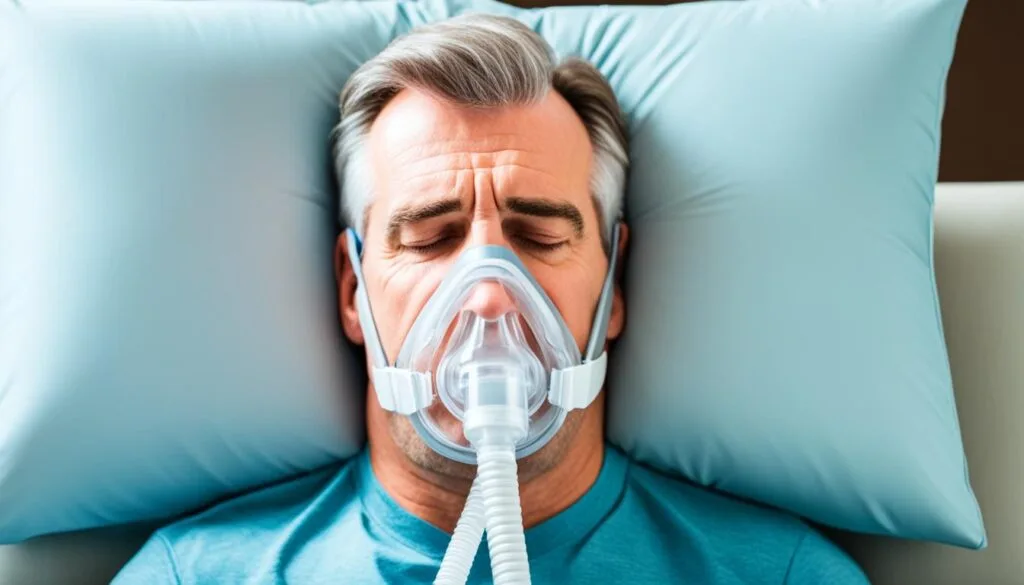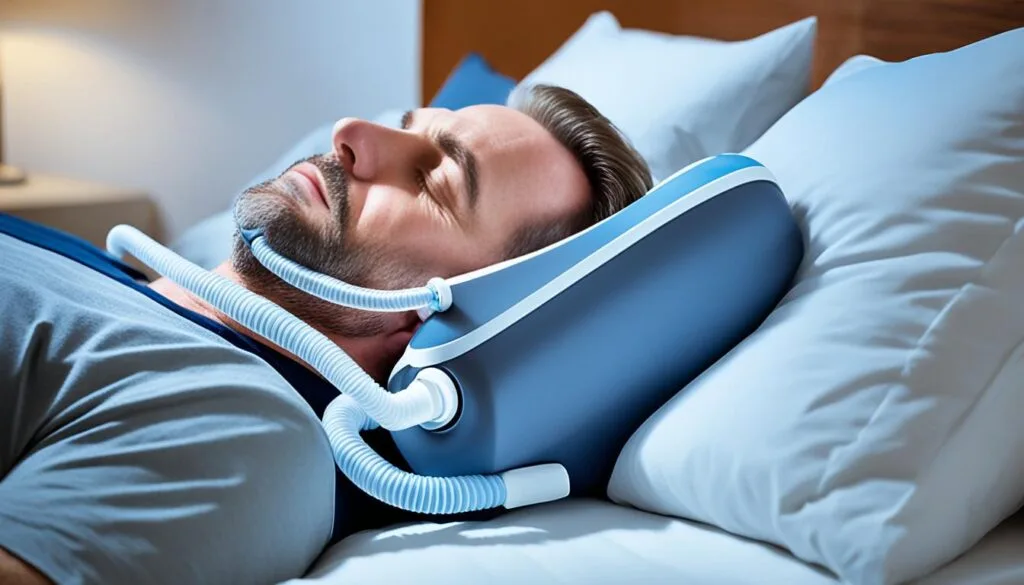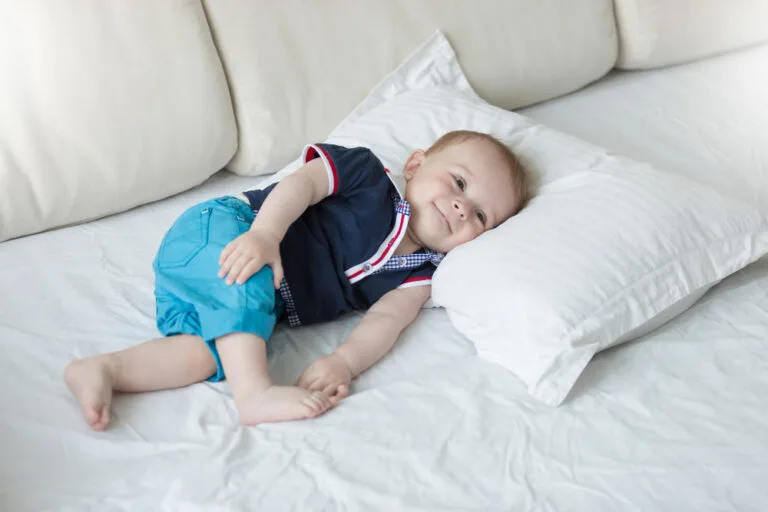CPAP nasal pillows are a big step forward for those with sleep apnea. They offer comfort and an easy way to sleep by providing air directly to the nostrils. This makes for a better night’s sleep without the bulk of traditional masks. Learning how to use these pillows well can hugely improve sleep therapy results.
Key Takeaways
- CPAP nasal pillows enhance comfort with their minimalistic design, allowing for a better sleep experience.
- Proper use of nasal pillows is key to successful and improved sleep apnea therapy.
- Understanding the fit and adjustment of CPAP nasal pillows is essential for efficient breathing.
- Adopting the correct breathing technique is crucial when using nasal pillows during CPAP therapy.
- CPAP therapy with nasal pillows can lead to significant improvements in managing sleep apnea symptoms.
The Lifesaving Benefits of CPAP Therapy
Understanding the lifesaving benefits of CPAP therapy is key for those battling sleep apnea. This condition makes you stop breathing often while sleeping. CPAP therapy has transformed lives, offering better sleep and lower health risks from sleep disorders.
CPAP keeps your airway open with a steady air flow. This connection to improved sleep quality is vital for health. Patients see a major drop in daytime tiredness. They also enjoy better thinking and mood.
The reduced health risks from using CPAP are huge. Research shows that using CPAP cuts down on heart problems linked to sleep apnea. This makes CPAP therapy a key tool in health care today.
- Continuous air pressure mitigates sleep apnea episodes.
- Consistent oxygen supply throughout sleep.
- Significant reduction in stroke and heart attack risk.
CPAP therapy does more than improve sleep. It boosts nightly oxygen levels and eases heart stress, leading to many health gains. People using CPAP feel a big change in their daily health. This shows the big impact CPAP can have on improving and protecting health.
Understanding CPAP Nasal Pillows
Individuals on CPAP therapy understand how important their device’s interface is. CPAP nasal pillows offer a user-friendly solution. They deliver air with minimal contact and work quietly. This makes them popular for people who need respiratory care while they sleep.
What Are CPAP Nasal Pillows?
CPAP nasal pillows are small and light. They fit right at the nostril’s entrance, sending air directly into the nose. This makes CPAP therapy less bothersome. Their design is perfect for anyone looking for comfort without sacrificing treatment effectiveness.
The Advantages Over Other CPAP Masks
Nasal pillow masks have clear advantages. They’re designed with the user in mind. Let’s explore some benefits:
- Comfort: They fit snugly, reducing facial discomfort. This helps users sleep better.
- Minimal Contact: These masks cover less of the face. This is great for those who feel trapped by their device.
- Quiet: Their design and venting mean they make less noise. So, they won’t disturb sleep.
- Advantages for Active Sleepers: They allow more movement. This is ideal for people who toss and turn.
- Facial Hair Friendliness: They work well for people with facial hair. There’s no need to shave for a good seal.
Knowing about CPAP nasal pillows helps patients choose the best option for them. This can lead to better therapy success and a higher quality of life.
How to Breathe with CPAP Nasal Pillows
Learning to breath with CPAP nasal pillows can be easy if you know how. Getting enough air is not just about feeling good. It also makes sure the treatment works well. It’s very important to use the right breathing technique when starting this therapy. Here are important steps to help you breathe right with CPAP nasal pillows.
- Nose Breathing: Focus on nose breathing. CPAP nasal pillows are made for that. It lets the air move smoothly, helping keep your airways open.
- Mouth Closed: Keeping the mouth closed stops the therapy pressure from leaking. This leakage can lower therapy success.
- Exhalation Control: With exhalation control, you help maintain the pressure needed to avoid airway collapse. It might take some practice to get right.
Using CPAP for the first time can seem hard. But, keeping a steady breathing pattern is very important. Over time, it gets easier. Remember, doing this every night will help you breath comfortably and well with your CPAP.
Maximizing Comfort with CPAP Nasal Pillows
Dealing with sleep apnea can be tough. But, getting cozy with CPAP nasal pillows can make a big difference. It can turn a rough night into a good sleep. The trick is to tailor the device for your needs. We’ll look into how to get a proper fit and how these pillows work for various sleeping positions.
Getting the Right Fit
Getting the right fit is crucial, not just for comfort but for the treatment to work. A proper fit stops air leaks and makes sure your CPAP machine works well. It begins with adjusting the headgear so the nasal pillows stay put without discomfort. The straps need to be tight enough to stay in place but not so tight they hurt.
To start, position the nasal pillows at your nostrils and pull the headgear on. Adjust the straps so they’re snug but not too tight. Then, move your head around to check the nasal pillows stay in place. You might want to try clip adjustments or padded straps to make it more comfortable.
CPAP Nasal Pillows for Different Sleeping Positions
Your sleeping position can change how your CPAP nasal pillows fit and work. Side sleepers might find their mask moves, but back sleepers may need to loosen the straps a bit. Finding the right spot for your pillow and adjusting the headgear for your sleep style is key.
- If you sleep on your side, look for a CPAP pillow with cutouts for the mask and hose.
- Back sleepers can try loosening the top straps a little for a better fit.
- Stomach sleepers need to keep their pillows low-profile to avoid too much mask pressure.
It’s important to tweak your CPAP nasal pillows setup if you shift positions during the night. Making it fit your needs helps you stay comfortable. This leads to sticking with your treatment and getting good sleep.
Improving Airflow with CPAP Nasal Pillows
Improving airflow is key for those using CPAP to tackle sleep apnea. The nasal pillow design directs airflow straight into the nostrils. It’s designed to promote nasal breathing, the best method for CPAP success. Ensuring a tight seal around the nostrils reduces air leakage. This helps users enjoy a full night’s sleep without interruptions.
Comfort and efficiency in CPAP airflow depend on how well nasal pillows fit. A proper fit stops air from escaping, allowing for comfortable breathing all night. Users need to check the fit of their nasal pillows often. Adjusting them helps avoid air leaks, ensuring effective CPAP therapy.
- Assessing the fit of nasal pillows to ensure they are snug yet comfortable, thereby minimizing potential disruptions to CPAP airflow.
- Regularly checking for signs of wear and tear that could affect the nasal pillow design and its ability to maintain an effective seal.
- Practicing nasal breathing to increase the efficacy of therapy and make the most of the designed airflow pattern.
- Addressing any issues with reduced air leakage promptly to maintain consistent therapy outcomes.
The main aim of using CPAP nasal pillows is to improve sleep quality. By focusing on customization and proper fit, users face fewer disruptions. This detailed attention is crucial in managing sleep apnea effectively.
Avoiding Common CPAP Nasal Pillow Pitfalls
Common pitfalls with CPAP nasal pillows often surprise new users. This can make their sleep apnea treatment less effective. Knowing and fixing these problems early is key for keeping the benefits of CPAP therapy. Two main issues are air leaks and claustrophobia. Both can be handled with the right troubleshooting and solutions.
Dealing with Air Leaks
Air leaks are a typical issue for CPAP users. They can disrupt sleep and lower therapy impact by reducing pressure. To handle air leaks, you need to:
- Ensure the nasal pillows fit well and are the right size
- Adjust the headgear for a good, comfortable seal
- Check the equipment often for any damage that may cause leaks
If air leaks don’t stop, talk to a sleep expert or equipment provider for more help.
Overcoming Claustrophobia
Using CPAP nasal pillows may make some feel claustrophobic. It’s vital to deal with this feeling early for effective treatment. To beat claustrophobia:
- Get to know your device during the day, not just at bedtime.
- Use it for short times while awake, increasing slowly.
- Try deep breathing or guided imagery to relax.
With time and effort, most can get used to CPAP nasal pillows and keep up their therapy.
Troubleshooting CPAP Nasal Pillows Issues
Some individuals may face challenges with CPAP nasal pillows. These challenges could hinder the comfort and success of sleep therapy. Recognizing and addressing these issues is crucial for a successful CPAP routine.
Addressing Dryness and Irritation
Dryness and irritation can trouble CPAP nasal pillow users. It’s vital to solve these problems. You can manage discomfort by taking a few steps:
- Use a CPAP machine with a built-in humidifier to moisten the air.
- Apply nasal saline spray or gel to moisten and soothe the nasal passages.
- Make sure the nasal pillows fit well to prevent air leakage and nose dryness.
Early symptom management of dryness or irritation ensures comfort and CPAP therapy compliance.
Maintaining Your CPAP Equipment
Keeping your CPAP equipment in good shape is key for its effectiveness and longevity. Follow these important tips for cleaning and maintaining your CPAP nasal pillows and gear:
- Before cleaning, take apart the nasal pillows, mask frame, and tubing.
- Daily, wash the nasal pillows with warm, soapy water to remove oils and debris.
- Once a week, thoroughly clean all CPAP parts, including the hose and mask.
- Follow the manufacturer’s recommendations for replacing nasal pillows and filters for best performance and hygiene.
A regular maintenance routine avoids hygiene issues and equipment wear, ensuring effective CPAP therapy.
Adapting to CPAP Nasal Pillows Breathing Techniques
Understanding and patience are essential when adapting to CPAP nasal pillows. For many, this switch is a big change. Using certain breathing techniques and practicing regularly can help. This makes adjusting to CPAP therapy more comfortable. An gradual adjustment period lets users get used to the nasal pillows. At first, they may feel strange.
- Begin by using the CPAP nasal pillows during the day while awake. This can be when you’re reading or watching TV. It helps you get used to how they feel and fit.
- Try deep, steady nose-breathing. This gets you used to the air flow for when you sleep.
- Slowly increase how long you use the nasal pillows at night. This builds your tolerance and comfort.
Practice is crucial in adapting to CPAP therapy. It might feel odd at first to use the device. But with time, most users find it becomes natural. Stay positive during the gradual adjustment period. If you have trouble, talk to a healthcare pro. They can make sure your device’s fit and settings are right.
- Do relaxation exercises or mindfulness before bed to ease anxiety about wearing the device.
- Keep a regular routine. This tells your body it’s sleep time. It makes using the nasal pillows feel like a normal part of bedtime.
Adapting well to CPAP nasal pillows and mastering breathing techniques can greatly improve sleep apnea treatment. With the correct attitude and approach, you can move towards better sleep health smoothly and successfully.
Using CPAP Nasal Pillows Effectively for Sleep Apnea
CPAP nasal pillows are crucial in fighting sleep apnea, providing key support for better sleep. Starting CPAP therapy is a big step. It means committing to better breathing at night.
To manage sleep apnea well, use the tech carefully and learn how to improve therapy. This means checking sleep quality often and adjusting the machine’s pressure to meet your needs.
The Role of CPAP in Managing Sleep Apnea
For many, starting CPAP therapy marks a new chapter in achieving restful sleep and energy. CPAP nasal pillows help keep breathing steady by preventing sleep apnea’s breathing pauses. CPAP does more than ease symptoms; it protects long-term health too.
Monitoring Sleep Quality and Adjusting Pressure
- Sleep quality monitoring is key in making the most of CPAP therapy. Devices like sleep trackers give important info on how you sleep.
- By looking at sleep data carefully, patients and doctors can tailor CPAP therapy to fit better. This makes treatment more effective.
- Seeing a doctor regularly helps fine-tune the therapy. It’s also a chance to spot other issues that might affect your treatment.
Understanding how CPAP use, adjustments, and sleep monitoring work together helps achieve a good night’s sleep. This approach unlocks the full benefits of CPAP therapy.
CPAP Nasal Pillows for Beginners: A Step-by-Step Guide
Starting with CPAP therapy is a big move towards better health and sleep quality. For beginners, using CPAP nasal pillows for beginners helps make this journey easier. This guide will help you understand your equipment and how to use it every night.
Step 1: Understanding the Basics
Learning how CPAP machines work is crucial for new users. It’s important to know all about the constant air pressure they provide. CPAP nasal pillows, which fit into your nose, are where the air comes through. So, understanding CPAP therapy is a key starting point.
Step 2: Daily Routines for CPAP Compliance
To make CPAP therapy a part of your life, you need a routine. This means setting up your machine nightly, keeping nasal pillows clean, and making sure everything fits well. These steps help you get the most out of your treatment for better sleep and health.
- Evening preparation of CPAP equipment
- Regular cleaning of nasal pillows and other components
- Pre-sleep relaxation techniques to ease the transition
- Monitoring and adjusting for a secure, leak-free fit
Seeing CPAP therapy in a positive light makes a big difference. Think of it as improving your lifestyle, not as an inconvenience. With the right approach, using CPAP nasal pillows can become a simple part of your nightly routine.
Conclusion
In our journey, we’ve looked deeply into how CPAP therapy works. We’ve seen the big role CPAP nasal pillows have in treating sleep apnea. They mix comfort with effectiveness in a big way. Using CPAP nasal pillows lets people with sleep apnea sleep much better. This isn’t just about sleeping well. It’s also about feeling refreshed, healthier, and more alive.
It’s key to learn how to use and care for CPAP nasal pillows properly. This means choosing the right size and learning how to breathe correctly. Patience and practice will make this a comfortable routine. Knowing how to use these tools well is very important. It helps them work better, so you sleep better.
In the end, CPAP nasal pillows offer real hope to many looking for a good night’s sleep. Behind the quiet night is the hope for happier days, thanks to good sleep from CPAP therapy. If you follow the advice given, getting the most out of CPAP therapy is expected. For those wanting better sleep, this is a real hope.









